Heart Rate and Blood Pressure Regulation During Cycling and Recovery
VerifiedAdded on 2020/12/26
|12
|2073
|64
Report
AI Summary
This report delves into the intricate relationship between heart rate (HR) and blood pressure (BP), focusing on their regulation during rest, cycling exercise, and post-exercise recovery. The report explores the role of the sinus node, sympathetic and parasympathetic nervous systems, and cardiac output in HR and BP control. It highlights the changes in HR and BP during cycling, emphasizing the increased demand for blood supply and the subsequent physiological responses. The report further examines post-exercise changes, including the restoration of HR and BP to normal ranges, and discusses the influence of exercise intensity on cardiovascular responses. It concludes by emphasizing the importance of understanding these physiological patterns for maintaining cardiovascular health, particularly for individuals with hypertension or related risks. The report also references several scholarly articles and online resources to support its findings.
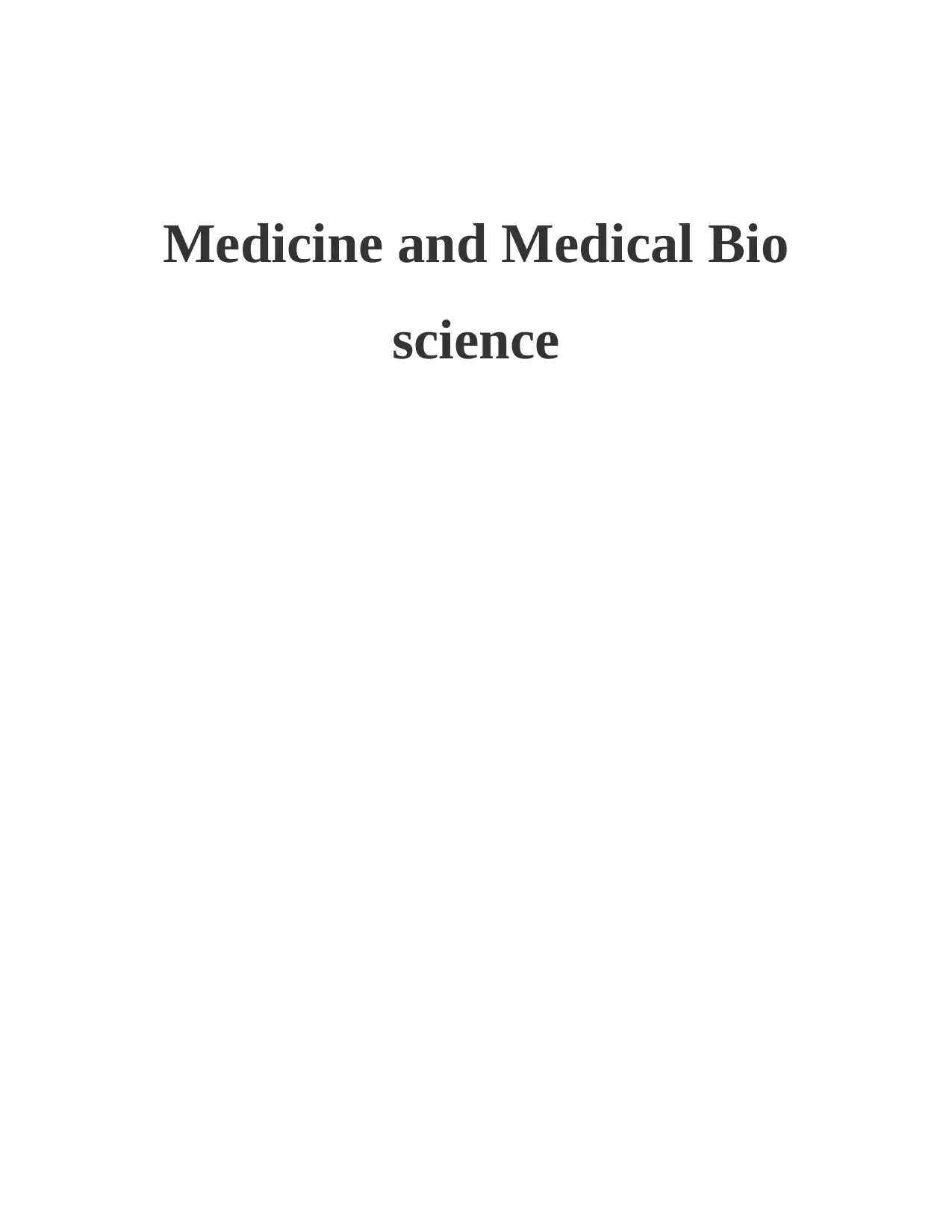
Medicine and Medical Bio
science
science
Paraphrase This Document
Need a fresh take? Get an instant paraphrase of this document with our AI Paraphraser
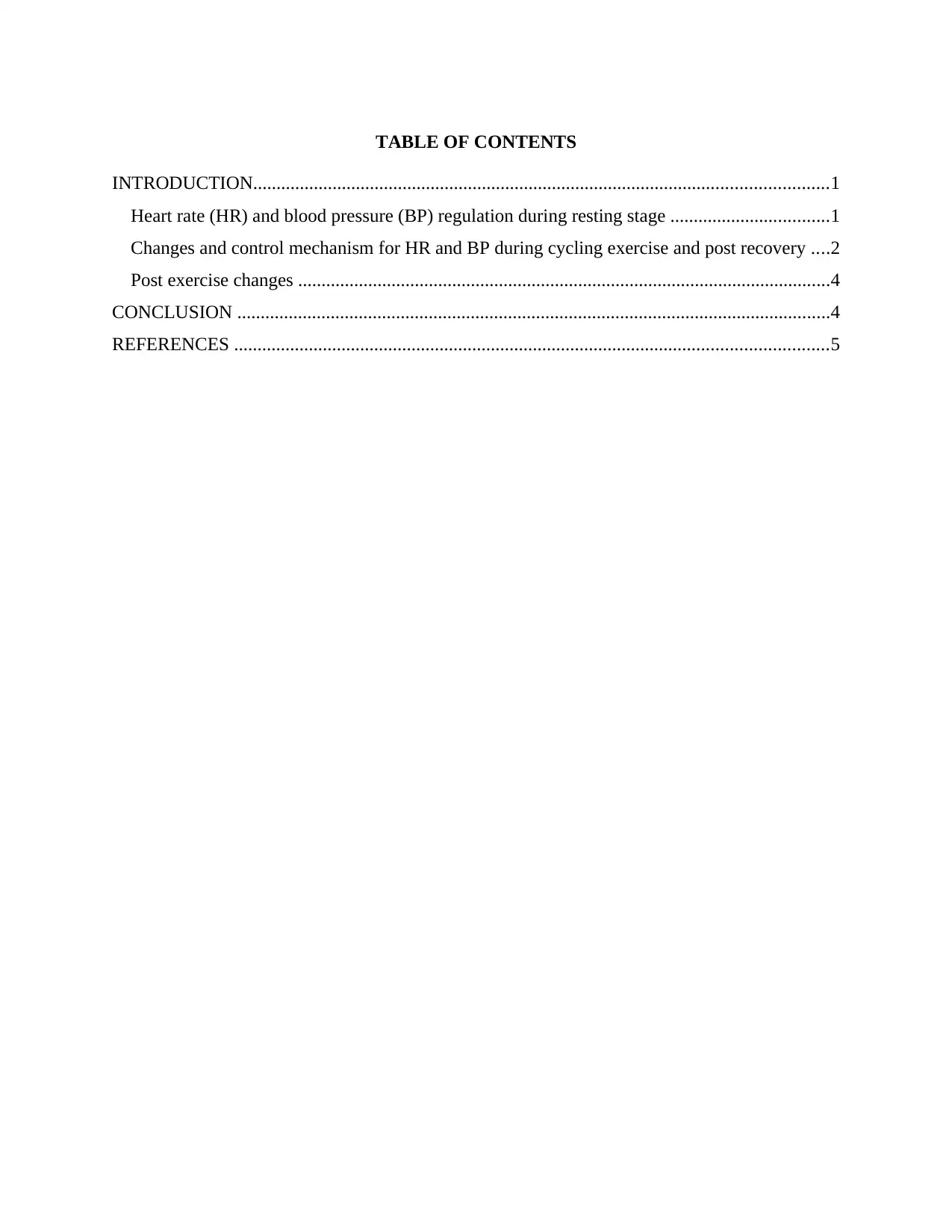
TABLE OF CONTENTS
INTRODUCTION...........................................................................................................................1
Heart rate (HR) and blood pressure (BP) regulation during resting stage ..................................1
Changes and control mechanism for HR and BP during cycling exercise and post recovery ....2
Post exercise changes ..................................................................................................................4
CONCLUSION ...............................................................................................................................4
REFERENCES ...............................................................................................................................5
INTRODUCTION...........................................................................................................................1
Heart rate (HR) and blood pressure (BP) regulation during resting stage ..................................1
Changes and control mechanism for HR and BP during cycling exercise and post recovery ....2
Post exercise changes ..................................................................................................................4
CONCLUSION ...............................................................................................................................4
REFERENCES ...............................................................................................................................5
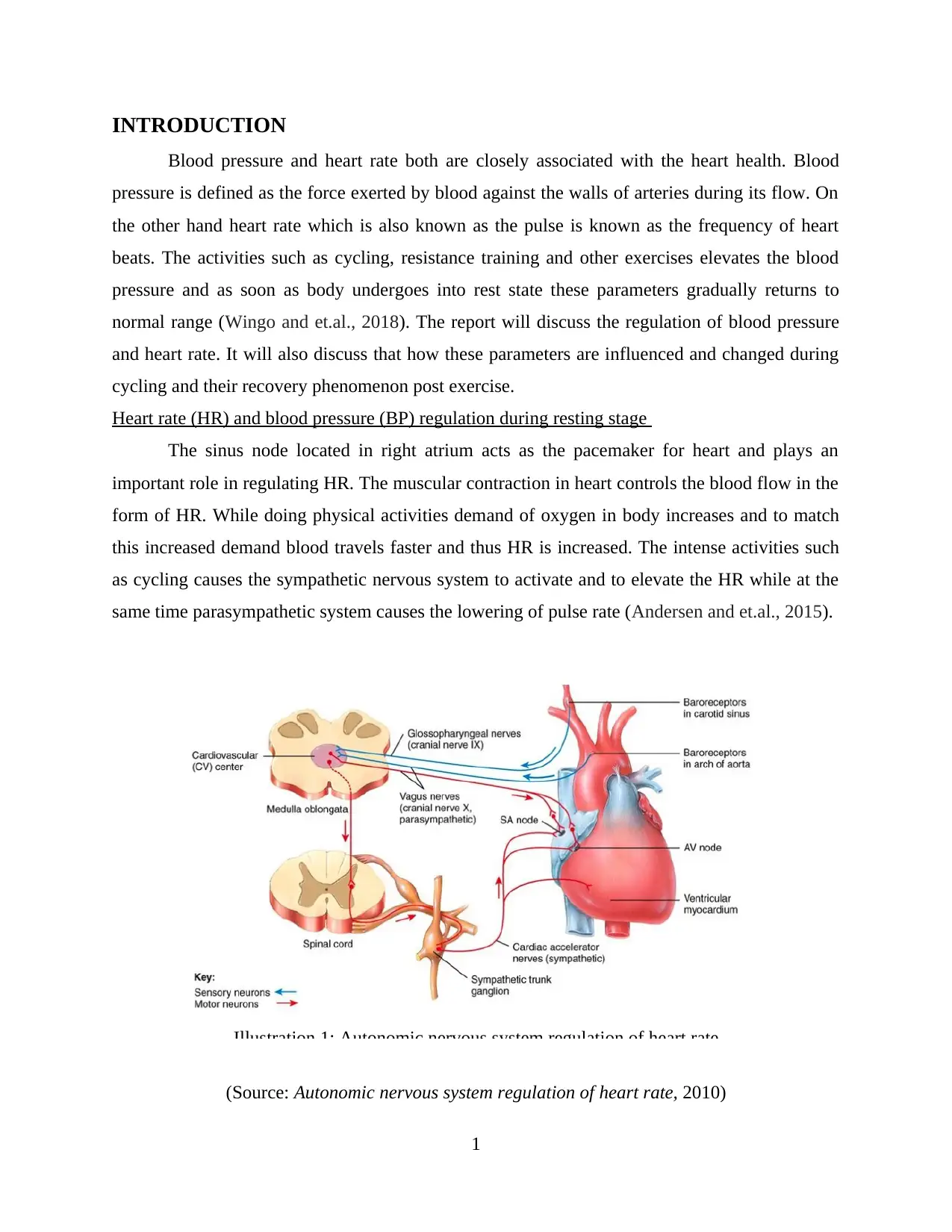
INTRODUCTION
Blood pressure and heart rate both are closely associated with the heart health. Blood
pressure is defined as the force exerted by blood against the walls of arteries during its flow. On
the other hand heart rate which is also known as the pulse is known as the frequency of heart
beats. The activities such as cycling, resistance training and other exercises elevates the blood
pressure and as soon as body undergoes into rest state these parameters gradually returns to
normal range (Wingo and et.al., 2018). The report will discuss the regulation of blood pressure
and heart rate. It will also discuss that how these parameters are influenced and changed during
cycling and their recovery phenomenon post exercise.
Heart rate (HR) and blood pressure (BP) regulation during resting stage
The sinus node located in right atrium acts as the pacemaker for heart and plays an
important role in regulating HR. The muscular contraction in heart controls the blood flow in the
form of HR. While doing physical activities demand of oxygen in body increases and to match
this increased demand blood travels faster and thus HR is increased. The intense activities such
as cycling causes the sympathetic nervous system to activate and to elevate the HR while at the
same time parasympathetic system causes the lowering of pulse rate (Andersen and et.al., 2015).
(Source: Autonomic nervous system regulation of heart rate, 2010)
1
Illustration 1: Autonomic nervous system regulation of heart rate
Blood pressure and heart rate both are closely associated with the heart health. Blood
pressure is defined as the force exerted by blood against the walls of arteries during its flow. On
the other hand heart rate which is also known as the pulse is known as the frequency of heart
beats. The activities such as cycling, resistance training and other exercises elevates the blood
pressure and as soon as body undergoes into rest state these parameters gradually returns to
normal range (Wingo and et.al., 2018). The report will discuss the regulation of blood pressure
and heart rate. It will also discuss that how these parameters are influenced and changed during
cycling and their recovery phenomenon post exercise.
Heart rate (HR) and blood pressure (BP) regulation during resting stage
The sinus node located in right atrium acts as the pacemaker for heart and plays an
important role in regulating HR. The muscular contraction in heart controls the blood flow in the
form of HR. While doing physical activities demand of oxygen in body increases and to match
this increased demand blood travels faster and thus HR is increased. The intense activities such
as cycling causes the sympathetic nervous system to activate and to elevate the HR while at the
same time parasympathetic system causes the lowering of pulse rate (Andersen and et.al., 2015).
(Source: Autonomic nervous system regulation of heart rate, 2010)
1
Illustration 1: Autonomic nervous system regulation of heart rate
⊘ This is a preview!⊘
Do you want full access?
Subscribe today to unlock all pages.

Trusted by 1+ million students worldwide
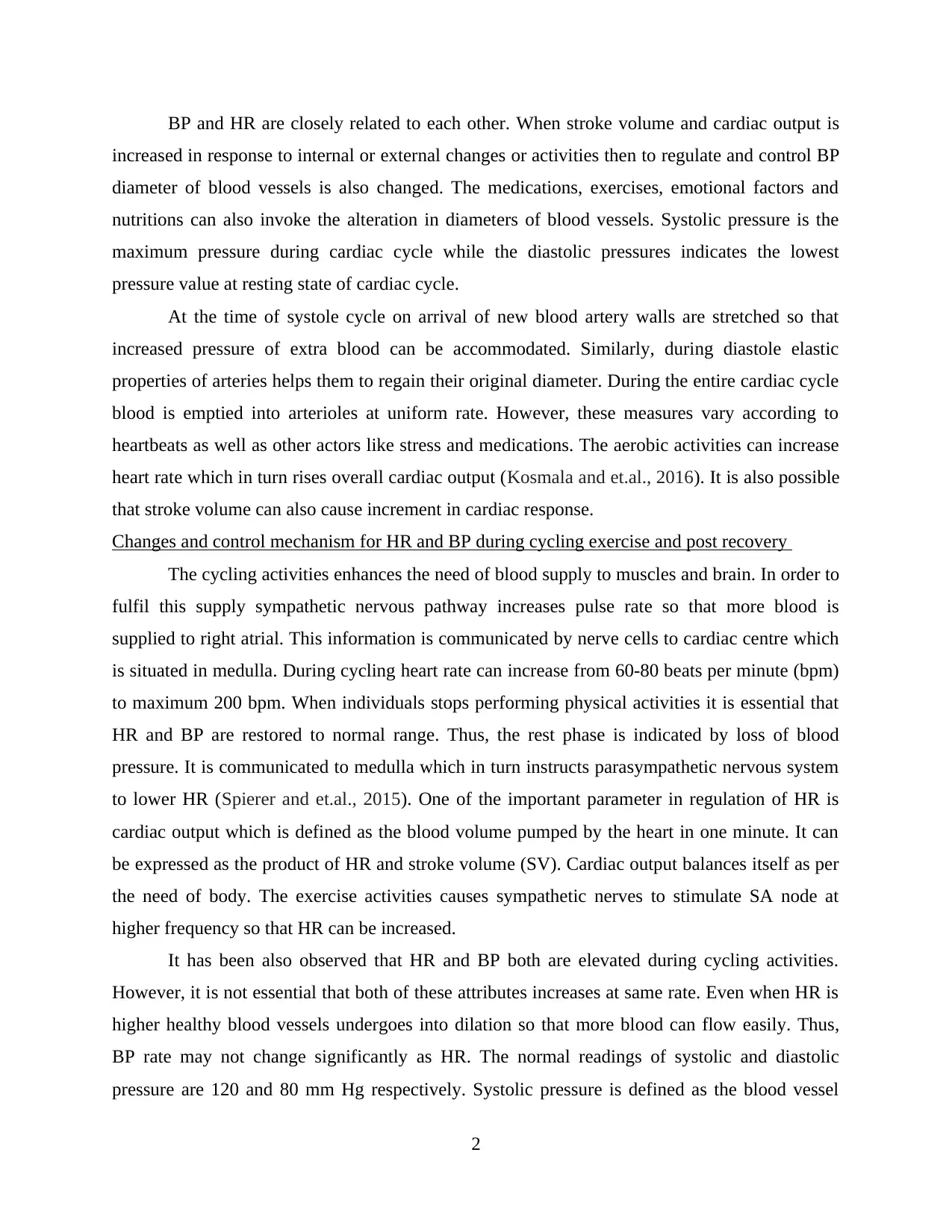
BP and HR are closely related to each other. When stroke volume and cardiac output is
increased in response to internal or external changes or activities then to regulate and control BP
diameter of blood vessels is also changed. The medications, exercises, emotional factors and
nutritions can also invoke the alteration in diameters of blood vessels. Systolic pressure is the
maximum pressure during cardiac cycle while the diastolic pressures indicates the lowest
pressure value at resting state of cardiac cycle.
At the time of systole cycle on arrival of new blood artery walls are stretched so that
increased pressure of extra blood can be accommodated. Similarly, during diastole elastic
properties of arteries helps them to regain their original diameter. During the entire cardiac cycle
blood is emptied into arterioles at uniform rate. However, these measures vary according to
heartbeats as well as other actors like stress and medications. The aerobic activities can increase
heart rate which in turn rises overall cardiac output (Kosmala and et.al., 2016). It is also possible
that stroke volume can also cause increment in cardiac response.
Changes and control mechanism for HR and BP during cycling exercise and post recovery
The cycling activities enhances the need of blood supply to muscles and brain. In order to
fulfil this supply sympathetic nervous pathway increases pulse rate so that more blood is
supplied to right atrial. This information is communicated by nerve cells to cardiac centre which
is situated in medulla. During cycling heart rate can increase from 60-80 beats per minute (bpm)
to maximum 200 bpm. When individuals stops performing physical activities it is essential that
HR and BP are restored to normal range. Thus, the rest phase is indicated by loss of blood
pressure. It is communicated to medulla which in turn instructs parasympathetic nervous system
to lower HR (Spierer and et.al., 2015). One of the important parameter in regulation of HR is
cardiac output which is defined as the blood volume pumped by the heart in one minute. It can
be expressed as the product of HR and stroke volume (SV). Cardiac output balances itself as per
the need of body. The exercise activities causes sympathetic nerves to stimulate SA node at
higher frequency so that HR can be increased.
It has been also observed that HR and BP both are elevated during cycling activities.
However, it is not essential that both of these attributes increases at same rate. Even when HR is
higher healthy blood vessels undergoes into dilation so that more blood can flow easily. Thus,
BP rate may not change significantly as HR. The normal readings of systolic and diastolic
pressure are 120 and 80 mm Hg respectively. Systolic pressure is defined as the blood vessel
2
increased in response to internal or external changes or activities then to regulate and control BP
diameter of blood vessels is also changed. The medications, exercises, emotional factors and
nutritions can also invoke the alteration in diameters of blood vessels. Systolic pressure is the
maximum pressure during cardiac cycle while the diastolic pressures indicates the lowest
pressure value at resting state of cardiac cycle.
At the time of systole cycle on arrival of new blood artery walls are stretched so that
increased pressure of extra blood can be accommodated. Similarly, during diastole elastic
properties of arteries helps them to regain their original diameter. During the entire cardiac cycle
blood is emptied into arterioles at uniform rate. However, these measures vary according to
heartbeats as well as other actors like stress and medications. The aerobic activities can increase
heart rate which in turn rises overall cardiac output (Kosmala and et.al., 2016). It is also possible
that stroke volume can also cause increment in cardiac response.
Changes and control mechanism for HR and BP during cycling exercise and post recovery
The cycling activities enhances the need of blood supply to muscles and brain. In order to
fulfil this supply sympathetic nervous pathway increases pulse rate so that more blood is
supplied to right atrial. This information is communicated by nerve cells to cardiac centre which
is situated in medulla. During cycling heart rate can increase from 60-80 beats per minute (bpm)
to maximum 200 bpm. When individuals stops performing physical activities it is essential that
HR and BP are restored to normal range. Thus, the rest phase is indicated by loss of blood
pressure. It is communicated to medulla which in turn instructs parasympathetic nervous system
to lower HR (Spierer and et.al., 2015). One of the important parameter in regulation of HR is
cardiac output which is defined as the blood volume pumped by the heart in one minute. It can
be expressed as the product of HR and stroke volume (SV). Cardiac output balances itself as per
the need of body. The exercise activities causes sympathetic nerves to stimulate SA node at
higher frequency so that HR can be increased.
It has been also observed that HR and BP both are elevated during cycling activities.
However, it is not essential that both of these attributes increases at same rate. Even when HR is
higher healthy blood vessels undergoes into dilation so that more blood can flow easily. Thus,
BP rate may not change significantly as HR. The normal readings of systolic and diastolic
pressure are 120 and 80 mm Hg respectively. Systolic pressure is defined as the blood vessel
2
Paraphrase This Document
Need a fresh take? Get an instant paraphrase of this document with our AI Paraphraser
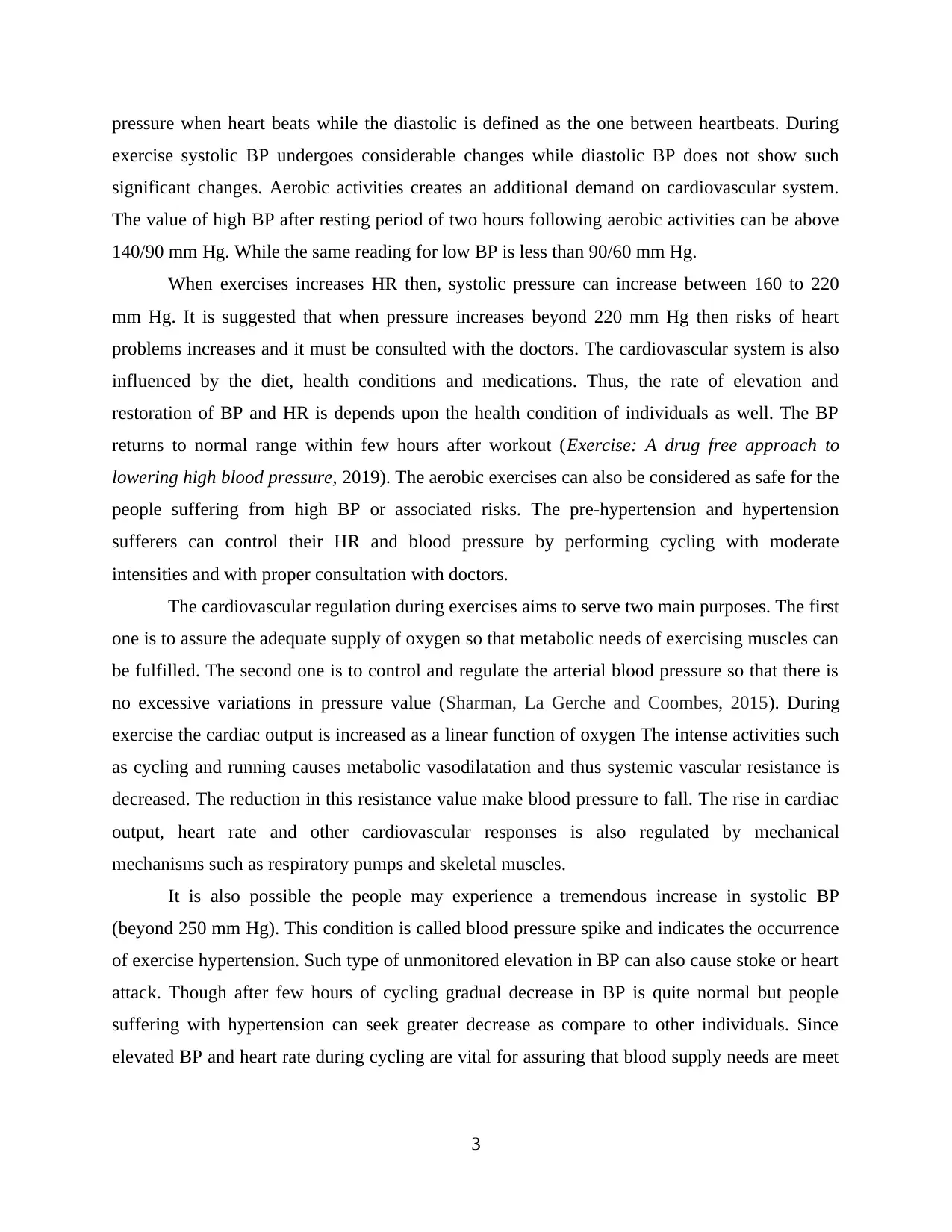
pressure when heart beats while the diastolic is defined as the one between heartbeats. During
exercise systolic BP undergoes considerable changes while diastolic BP does not show such
significant changes. Aerobic activities creates an additional demand on cardiovascular system.
The value of high BP after resting period of two hours following aerobic activities can be above
140/90 mm Hg. While the same reading for low BP is less than 90/60 mm Hg.
When exercises increases HR then, systolic pressure can increase between 160 to 220
mm Hg. It is suggested that when pressure increases beyond 220 mm Hg then risks of heart
problems increases and it must be consulted with the doctors. The cardiovascular system is also
influenced by the diet, health conditions and medications. Thus, the rate of elevation and
restoration of BP and HR is depends upon the health condition of individuals as well. The BP
returns to normal range within few hours after workout (Exercise: A drug free approach to
lowering high blood pressure, 2019). The aerobic exercises can also be considered as safe for the
people suffering from high BP or associated risks. The pre-hypertension and hypertension
sufferers can control their HR and blood pressure by performing cycling with moderate
intensities and with proper consultation with doctors.
The cardiovascular regulation during exercises aims to serve two main purposes. The first
one is to assure the adequate supply of oxygen so that metabolic needs of exercising muscles can
be fulfilled. The second one is to control and regulate the arterial blood pressure so that there is
no excessive variations in pressure value (Sharman, La Gerche and Coombes, 2015). During
exercise the cardiac output is increased as a linear function of oxygen The intense activities such
as cycling and running causes metabolic vasodilatation and thus systemic vascular resistance is
decreased. The reduction in this resistance value make blood pressure to fall. The rise in cardiac
output, heart rate and other cardiovascular responses is also regulated by mechanical
mechanisms such as respiratory pumps and skeletal muscles.
It is also possible the people may experience a tremendous increase in systolic BP
(beyond 250 mm Hg). This condition is called blood pressure spike and indicates the occurrence
of exercise hypertension. Such type of unmonitored elevation in BP can also cause stoke or heart
attack. Though after few hours of cycling gradual decrease in BP is quite normal but people
suffering with hypertension can seek greater decrease as compare to other individuals. Since
elevated BP and heart rate during cycling are vital for assuring that blood supply needs are meet
3
exercise systolic BP undergoes considerable changes while diastolic BP does not show such
significant changes. Aerobic activities creates an additional demand on cardiovascular system.
The value of high BP after resting period of two hours following aerobic activities can be above
140/90 mm Hg. While the same reading for low BP is less than 90/60 mm Hg.
When exercises increases HR then, systolic pressure can increase between 160 to 220
mm Hg. It is suggested that when pressure increases beyond 220 mm Hg then risks of heart
problems increases and it must be consulted with the doctors. The cardiovascular system is also
influenced by the diet, health conditions and medications. Thus, the rate of elevation and
restoration of BP and HR is depends upon the health condition of individuals as well. The BP
returns to normal range within few hours after workout (Exercise: A drug free approach to
lowering high blood pressure, 2019). The aerobic exercises can also be considered as safe for the
people suffering from high BP or associated risks. The pre-hypertension and hypertension
sufferers can control their HR and blood pressure by performing cycling with moderate
intensities and with proper consultation with doctors.
The cardiovascular regulation during exercises aims to serve two main purposes. The first
one is to assure the adequate supply of oxygen so that metabolic needs of exercising muscles can
be fulfilled. The second one is to control and regulate the arterial blood pressure so that there is
no excessive variations in pressure value (Sharman, La Gerche and Coombes, 2015). During
exercise the cardiac output is increased as a linear function of oxygen The intense activities such
as cycling and running causes metabolic vasodilatation and thus systemic vascular resistance is
decreased. The reduction in this resistance value make blood pressure to fall. The rise in cardiac
output, heart rate and other cardiovascular responses is also regulated by mechanical
mechanisms such as respiratory pumps and skeletal muscles.
It is also possible the people may experience a tremendous increase in systolic BP
(beyond 250 mm Hg). This condition is called blood pressure spike and indicates the occurrence
of exercise hypertension. Such type of unmonitored elevation in BP can also cause stoke or heart
attack. Though after few hours of cycling gradual decrease in BP is quite normal but people
suffering with hypertension can seek greater decrease as compare to other individuals. Since
elevated BP and heart rate during cycling are vital for assuring that blood supply needs are meet
3
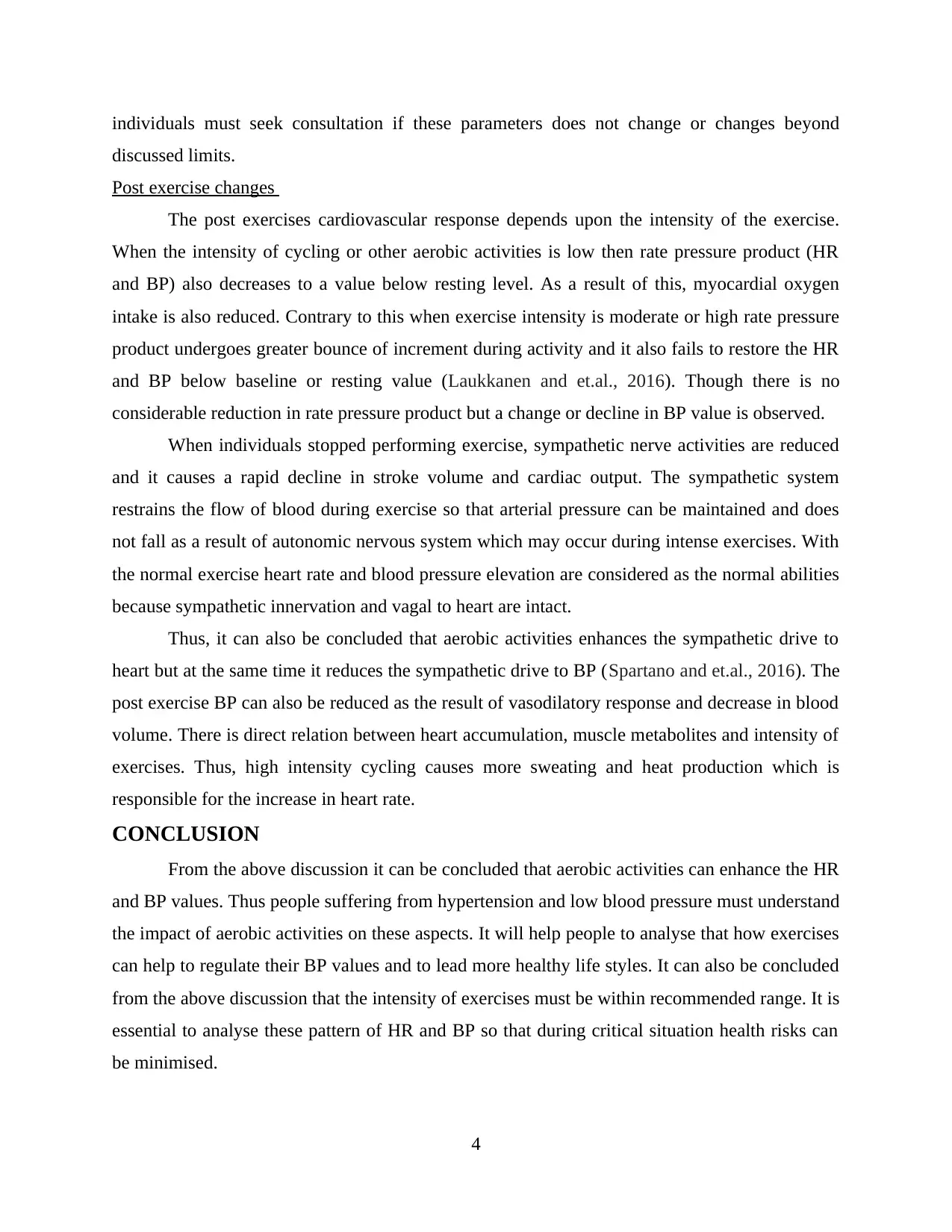
individuals must seek consultation if these parameters does not change or changes beyond
discussed limits.
Post exercise changes
The post exercises cardiovascular response depends upon the intensity of the exercise.
When the intensity of cycling or other aerobic activities is low then rate pressure product (HR
and BP) also decreases to a value below resting level. As a result of this, myocardial oxygen
intake is also reduced. Contrary to this when exercise intensity is moderate or high rate pressure
product undergoes greater bounce of increment during activity and it also fails to restore the HR
and BP below baseline or resting value (Laukkanen and et.al., 2016). Though there is no
considerable reduction in rate pressure product but a change or decline in BP value is observed.
When individuals stopped performing exercise, sympathetic nerve activities are reduced
and it causes a rapid decline in stroke volume and cardiac output. The sympathetic system
restrains the flow of blood during exercise so that arterial pressure can be maintained and does
not fall as a result of autonomic nervous system which may occur during intense exercises. With
the normal exercise heart rate and blood pressure elevation are considered as the normal abilities
because sympathetic innervation and vagal to heart are intact.
Thus, it can also be concluded that aerobic activities enhances the sympathetic drive to
heart but at the same time it reduces the sympathetic drive to BP (Spartano and et.al., 2016). The
post exercise BP can also be reduced as the result of vasodilatory response and decrease in blood
volume. There is direct relation between heart accumulation, muscle metabolites and intensity of
exercises. Thus, high intensity cycling causes more sweating and heat production which is
responsible for the increase in heart rate.
CONCLUSION
From the above discussion it can be concluded that aerobic activities can enhance the HR
and BP values. Thus people suffering from hypertension and low blood pressure must understand
the impact of aerobic activities on these aspects. It will help people to analyse that how exercises
can help to regulate their BP values and to lead more healthy life styles. It can also be concluded
from the above discussion that the intensity of exercises must be within recommended range. It is
essential to analyse these pattern of HR and BP so that during critical situation health risks can
be minimised.
4
discussed limits.
Post exercise changes
The post exercises cardiovascular response depends upon the intensity of the exercise.
When the intensity of cycling or other aerobic activities is low then rate pressure product (HR
and BP) also decreases to a value below resting level. As a result of this, myocardial oxygen
intake is also reduced. Contrary to this when exercise intensity is moderate or high rate pressure
product undergoes greater bounce of increment during activity and it also fails to restore the HR
and BP below baseline or resting value (Laukkanen and et.al., 2016). Though there is no
considerable reduction in rate pressure product but a change or decline in BP value is observed.
When individuals stopped performing exercise, sympathetic nerve activities are reduced
and it causes a rapid decline in stroke volume and cardiac output. The sympathetic system
restrains the flow of blood during exercise so that arterial pressure can be maintained and does
not fall as a result of autonomic nervous system which may occur during intense exercises. With
the normal exercise heart rate and blood pressure elevation are considered as the normal abilities
because sympathetic innervation and vagal to heart are intact.
Thus, it can also be concluded that aerobic activities enhances the sympathetic drive to
heart but at the same time it reduces the sympathetic drive to BP (Spartano and et.al., 2016). The
post exercise BP can also be reduced as the result of vasodilatory response and decrease in blood
volume. There is direct relation between heart accumulation, muscle metabolites and intensity of
exercises. Thus, high intensity cycling causes more sweating and heat production which is
responsible for the increase in heart rate.
CONCLUSION
From the above discussion it can be concluded that aerobic activities can enhance the HR
and BP values. Thus people suffering from hypertension and low blood pressure must understand
the impact of aerobic activities on these aspects. It will help people to analyse that how exercises
can help to regulate their BP values and to lead more healthy life styles. It can also be concluded
from the above discussion that the intensity of exercises must be within recommended range. It is
essential to analyse these pattern of HR and BP so that during critical situation health risks can
be minimised.
4
⊘ This is a preview!⊘
Do you want full access?
Subscribe today to unlock all pages.

Trusted by 1+ million students worldwide
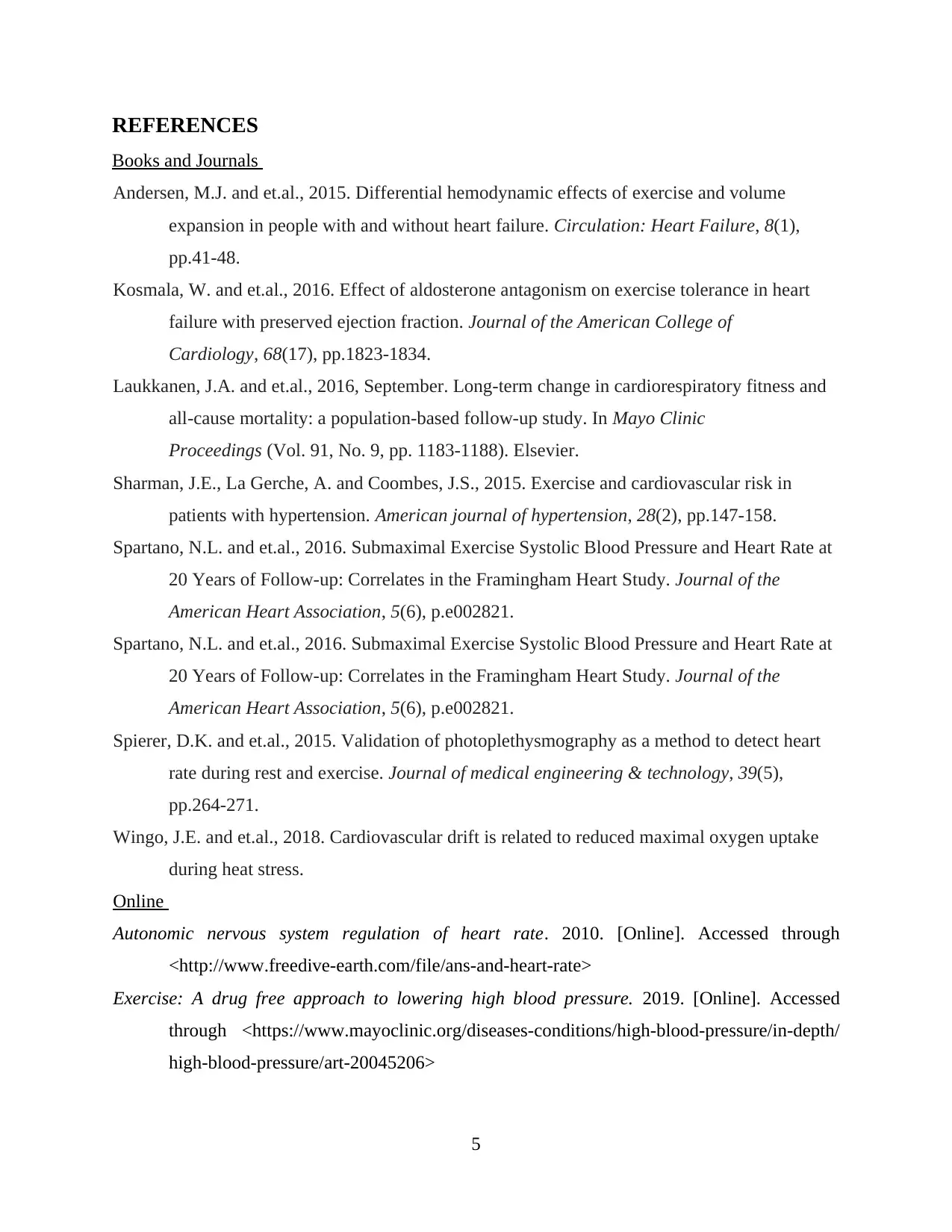
REFERENCES
Books and Journals
Andersen, M.J. and et.al., 2015. Differential hemodynamic effects of exercise and volume
expansion in people with and without heart failure. Circulation: Heart Failure, 8(1),
pp.41-48.
Kosmala, W. and et.al., 2016. Effect of aldosterone antagonism on exercise tolerance in heart
failure with preserved ejection fraction. Journal of the American College of
Cardiology, 68(17), pp.1823-1834.
Laukkanen, J.A. and et.al., 2016, September. Long-term change in cardiorespiratory fitness and
all-cause mortality: a population-based follow-up study. In Mayo Clinic
Proceedings (Vol. 91, No. 9, pp. 1183-1188). Elsevier.
Sharman, J.E., La Gerche, A. and Coombes, J.S., 2015. Exercise and cardiovascular risk in
patients with hypertension. American journal of hypertension, 28(2), pp.147-158.
Spartano, N.L. and et.al., 2016. Submaximal Exercise Systolic Blood Pressure and Heart Rate at
20 Years of Follow‐up: Correlates in the Framingham Heart Study. Journal of the
American Heart Association, 5(6), p.e002821.
Spartano, N.L. and et.al., 2016. Submaximal Exercise Systolic Blood Pressure and Heart Rate at
20 Years of Follow‐up: Correlates in the Framingham Heart Study. Journal of the
American Heart Association, 5(6), p.e002821.
Spierer, D.K. and et.al., 2015. Validation of photoplethysmography as a method to detect heart
rate during rest and exercise. Journal of medical engineering & technology, 39(5),
pp.264-271.
Wingo, J.E. and et.al., 2018. Cardiovascular drift is related to reduced maximal oxygen uptake
during heat stress.
Online
Autonomic nervous system regulation of heart rate. 2010. [Online]. Accessed through
<http://www.freedive-earth.com/file/ans-and-heart-rate>
Exercise: A drug free approach to lowering high blood pressure. 2019. [Online]. Accessed
through <https://www.mayoclinic.org/diseases-conditions/high-blood-pressure/in-depth/
high-blood-pressure/art-20045206>
5
Books and Journals
Andersen, M.J. and et.al., 2015. Differential hemodynamic effects of exercise and volume
expansion in people with and without heart failure. Circulation: Heart Failure, 8(1),
pp.41-48.
Kosmala, W. and et.al., 2016. Effect of aldosterone antagonism on exercise tolerance in heart
failure with preserved ejection fraction. Journal of the American College of
Cardiology, 68(17), pp.1823-1834.
Laukkanen, J.A. and et.al., 2016, September. Long-term change in cardiorespiratory fitness and
all-cause mortality: a population-based follow-up study. In Mayo Clinic
Proceedings (Vol. 91, No. 9, pp. 1183-1188). Elsevier.
Sharman, J.E., La Gerche, A. and Coombes, J.S., 2015. Exercise and cardiovascular risk in
patients with hypertension. American journal of hypertension, 28(2), pp.147-158.
Spartano, N.L. and et.al., 2016. Submaximal Exercise Systolic Blood Pressure and Heart Rate at
20 Years of Follow‐up: Correlates in the Framingham Heart Study. Journal of the
American Heart Association, 5(6), p.e002821.
Spartano, N.L. and et.al., 2016. Submaximal Exercise Systolic Blood Pressure and Heart Rate at
20 Years of Follow‐up: Correlates in the Framingham Heart Study. Journal of the
American Heart Association, 5(6), p.e002821.
Spierer, D.K. and et.al., 2015. Validation of photoplethysmography as a method to detect heart
rate during rest and exercise. Journal of medical engineering & technology, 39(5),
pp.264-271.
Wingo, J.E. and et.al., 2018. Cardiovascular drift is related to reduced maximal oxygen uptake
during heat stress.
Online
Autonomic nervous system regulation of heart rate. 2010. [Online]. Accessed through
<http://www.freedive-earth.com/file/ans-and-heart-rate>
Exercise: A drug free approach to lowering high blood pressure. 2019. [Online]. Accessed
through <https://www.mayoclinic.org/diseases-conditions/high-blood-pressure/in-depth/
high-blood-pressure/art-20045206>
5
Paraphrase This Document
Need a fresh take? Get an instant paraphrase of this document with our AI Paraphraser

6

7
⊘ This is a preview!⊘
Do you want full access?
Subscribe today to unlock all pages.

Trusted by 1+ million students worldwide

8
Paraphrase This Document
Need a fresh take? Get an instant paraphrase of this document with our AI Paraphraser

9

10
⊘ This is a preview!⊘
Do you want full access?
Subscribe today to unlock all pages.

Trusted by 1+ million students worldwide
1 out of 12
Related Documents
Your All-in-One AI-Powered Toolkit for Academic Success.
+13062052269
info@desklib.com
Available 24*7 on WhatsApp / Email
![[object Object]](/_next/static/media/star-bottom.7253800d.svg)
Unlock your academic potential
Copyright © 2020–2025 A2Z Services. All Rights Reserved. Developed and managed by ZUCOL.





